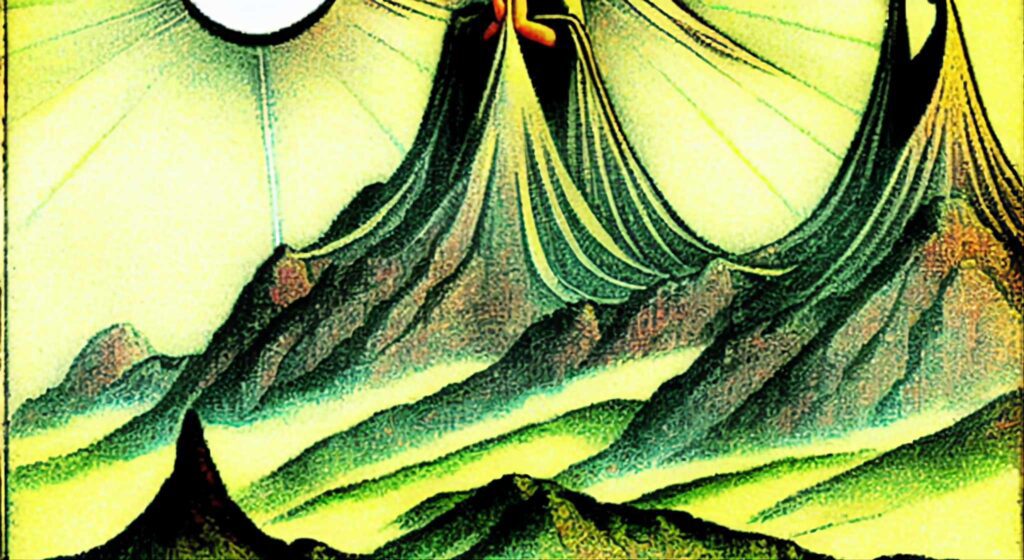Who is the third who walks always beside you?
When I count, there are only you and I together
But when I look ahead up the white road
There is always another one walking beside you
…
— But who is that on the other side of you?
T. S. Eliot, The Waste Land
Up on Mons Juval, whose Latin name means Jove’s mountain, in South Tyrol, we find the Castelo Juval, a castle owned by the renowned mountain climber and expeditionist Reinhold Messner.
Inside, its collection of portraits of sacred peaks and Tibetan artefacts reminds us of the initiatic character of mountains, how cultures throughout the world conceive of them as tomb/womb-like places in which the struggling seeker may experience ritual death and obtain spiritual rebirth. Juval in particular reminds us of Mount Ida in Crete, where the god Jove is said to have been protected as a child and crowned as a man and king. This was a place to which animal sacrifices were made and initiates underwent a Jove-like coronation (we have accounts of Pythagoras doing so, for example).
Mountains can be a place of encounter with the unseen, a high point where our world reaches up to the heavenly realm.
In his book The Naked Mountain, Reinhold Messner recounts a dire situation while climbing the Tibet’s Diamer mountain:
On one section of the front points of our crampons [they] were only biting a few millimetres deep into the glassy hard ice … At times our whole weight was on our crampons and axes.
Whereupon:
Suddenly there was a third climber next to me. He was descending with us, keeping a regular distance a little to my right and a few steps away from me, just out of my field of vision. I could not see the figure and still maintain my concentration but I was certain there was someone there. I could sense his presence; I needed no proof.
This is called the “Third Man Factor” (as explored by John Geiger in his book by the same name). It describes a recurring experience visited upon climbers and adventurers, such that they perceive a helper, an extra member of their band, aiding their advance.
Wrote the Anglo-Irish explorer Sir Ernest Shackleton of his expedition to the Antarctic:
When I look back at those days I have no doubt that Providence guided us, not only across those snow fields, but across the storm-white sea that separated Elephant Island from our landing place on South Georgia. I know that during that long and racking march of thirty-six hours over the unnamed mountains and glaciers of South Georgia it seemed to me often that we were four, not three. I said nothing to my companions on the point, but afterwards Worsley said to me, “Boss, I had a curious feeling on the march that there was another person with us.” Crean confessed to the same idea. One feels “the dearth of human words, the roughness of mortal speech” in trying to describe things intangible, but a record of our journeys would be incomplete without a reference to a subject very near to our hearts.
“Dearth of human words” and “roughness of mortal speech” are expressions John Keats uses in the Endymion and, for its part, the above account was the inspiration for the T.S. Eliot quote with which we began. It seems communicating the crisp danger, extraordinary vistas, and encounters with the unseen wrought by extreme, real-life situations requires a precision most suited to poetic language.

Indeed, the divine companion is also invoked in the often-cited 1958 poem “Footprints” by Lucille Veneklasen:
I walked the road to sorrow—a road so dark with care, so lonely, I was certain that no one else was there.
But suddenly around me were beams of light, stretched wide; and then I saw that someone was walking by my side.
And when I turned to notice this road which I had trod, I saw two sets of footprints—My own … and those of God.
Whether a local benevolent spirit living in the mountain, a ‘pet of God’ as the Yeti is sometimes described, or a person’s guardian angel, saintly intercessor, higher self, and ‘divine twin,’—a manifestation of God’s mercy to the pilgrim and adventurer—the supernatural agent in question brings support at a difficult juncture during the heroic trek.
Such is the role of the unseen other.
But beware—we may also encounter another ‘other:’
What is this that stands before me?
Figure in black which points at me
Turn ’round quick and start to run
Find out I’m the chosen one
Oh, no!
— Black Sabbath, “Black Sabbath”
The lyrics to Black Sabbath’s eponymous song are based on band member Geezer Butler’s vision of a sinister figure standing at the foot of his bed after he woke up from a nightmare in his occult imagery-clad apartment. This was apparently triggered by a book of Satanic lore singer Ozzy Osborne had brought Butler earlier.
This is the opposite of the Third Man as a helper. It is the haunter. The malevolent unseen who stalks us. The spectral presence that harasses sleep. The demon parasite incubi of sleep paralysis and similar states, with its many forms, reminds us that the imaginal and astral can be traversed by heavenly condescension as surely as it can be inhabited by demonic entities.
The haunted sleeper in between dream and wakefulness, and the climber in between earth and sky (or life and death) who receives help, present us with similar cases. They are both at a crossroads, encountering the unseen in liminal consciousness.

Indeed, the path of the pilgrim is often said to come up against a contrary presence. Spaniards tell of how one walking the Path of Santiago might meet the devil at some point, and American folklore is full of references to the sinister man who waits at forks in the road.
But accounts from climbers point us towards a formula for placing ourselves in the orbit of benevolence: adventure, attempting great feats, intensity, and effort. These are the way. Endurance, at the edge of our abilities, might bring us into contact with mercy.